1 Introduction
In line with recent methodological advances from the behavioral economics and social psychology literature, researchers in the field of consumer behavior are trying in addressing the conscious and nonconscious shopping behavior of consumers, attitude formation, and behavioral judgment responses (Dimofte 2010; Znanewitz et al. 2018). It can be argued that consumers are not always seeking absolute maximization over their choices, and they do not interpret the information presented on the decision tasks in terms of perceived positive or negative outcomes, like gains and losses (Van Osselaer 2011; Babutsidze 2012; McGraw et al. 2010. For example consumers connect their moods (e.g. happy/sad) with their preference judgments (Mason et al. 2023; Sheth et al. 1991).
On the other, the stimuli of information which can be used should focus on the distinction of internal and external one (Babutsidze 2012). The former are those that have been stored in memory from previous and past experiences, while the latter include information that acquired during the decision process (Tarnanidis et al. 2015). Hence, this research will try to analyze the consumer buying decision process in terms of how it is being affected by the use of reference points (RPs) in different time conditions. After reviewing the literature, the next section will focus on research methodology, analysis, and concluding remarks.
2 Literature review
According to the literature on cognition in marketing, consumers are more capable of evaluating and judging extrinsic cues (conscious parts of the brain) than intrinsic ones (non-conscious ones). It was discovered that consumers are unable to interpret all the intrinsic cues surrounding a product bundle due to their lack of tacit knowledge. Their goal is to capture and recognize various external cues that aid them in shaping their preferences. Specifically, the literature suggests that these cues should include multiple categories of constructs that affect consumer perceptions when making product decision-making evaluations, i.e. the knowledge that arises from past purchases, consumer goals and values. Alike the acquisition and the selection of products involves symbolic meanings to consumers that have a direct impact upon their own social image, identity and life (Arkes et al. 2007; Van Ravenzwaaij et al. 2014; Kurbanov 2023). Our analysis begins by gaining an understanding of the main inquiry that was made on reference points and highlighting the existing problems, as per research practice. It should be mentioned that the literature on the specific construct has been guided from the elaboration and development of prospect theory started from the work of Kahneman and Tversky (1979) and which has been placed as an alternative examination process to the principles of the existing utility theory (Bouchouicha and Vieider 2017) where preferences of diverse choices violate the axioms of the expected theory. Considering that the principle of utility theory is based on the absolute upper limit of choices and preferences (Shafir and Thaler 2006). In contrast with prospect theory it is commonly argued that individuals do not stand upon those axioms; instead they make subjective evaluations which can be regarded as irrational behavior. More plausible preferences are structured with relevance to a reference point, which has disproportionate outcomes on the impact of sensed gains and losses (e.g. Han et al. 2018; Mayhew and Winer 1992). Furthermore, it could be stated that consumers have time-inconsistent preferences that are being restricted by self structured heuristics and regularities that arise from social and self-interest considerations (Panzone, 2014).
In accordance with prospect theory on decision making under risk, it is believed that consumers/people underestimate or undervalue outcomes that are most probable compared to those that can be achieved with certainty. The primary argument of prospect theory is that every decision can be examined as a choice between prospects (reference points), and ultimately framing those prospects or violating them by anchoring them differently, and so one can exert more reliable solutions. For example, actors are faced with bounded rationality problems by employing multiple perspectives and distinct preferences, such as the gambling effect (losses and gains). Prospect theory’s findings suggest that consumers seek risks for losses that are below the reference level, while they are less inclined to take risks for gains that are above the reference level. This implies that consumers are risk-aversion when making choices that involve certain advantages, and risk-seeking when making choices that involve certain disadvantages.
Similarly, Thaler (2008) has examined the integration of aggregation effects, i.e. v(x) v(y) and the segregation effects of reference points, i.e. v(x+y). For example, „Mr. A was given tickets to two lotteries related to the World Series. In the first lottery, he received $50 and in the second, he received $25. Mr. B received a ticket for a single, larger World Series lottery. He won $75. Who was happier?“ (Thaler 1985, p. 203). The primary point is that two segregated gains have a greater impact on the actor’s expectations than a large equal gain. Conversely, the opposing viewpoint focuses on the quadrant of gains (Ghoshal et al. 2013). More analytically the value of v (50) +v (25) is greater than v (75) and the value of v (-50) +v (-25) is smaller than v (-75). We can say that the work of Thaler (2008) has introduced a new notion of „transaction Utility“, that is expressed in two consummative processes, where a decision of approval or denial of a specific transaction is based upon the careful evaluation of each transaction. Other researchers, i.e. Barkan et al. (2005), when investigating the puzzle of integration and segregation inside the process of planned and actual consumer choices have recognized the appearance of dynamic inconsistency biases. According to the authors, people acquire and possess a specific product more effectively than those who do not. In particular, they refer to the „endowment effect“, which was examined by Kahneman and Tversky (1979). Previously, Puto (1987), proposed a conceptual model of the buying decision framing process (see Figure 1), where the existence of an initial reference point is influenced by: a set of expectations, a set of distinct buying intentions (objectives) and a final reference point.
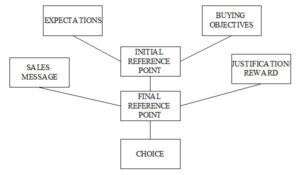
Figure 1: Reference points in the buying decision process
Source: Author according to Puto (1987, p. 303)
Consumers’ expectations and buying objectives are impacted by their past experiences, as observed by the authors, i.e. when they have acquired a product before (low expectations) or not (high expectations). Nonetheless, the present framework is more applicable to particular buying scenarios, specifically this framework has been produced in order to analyze the decision making procedure of industrial buyers, without offering justifiable generalizations to other settings. Bearing that in mind, Puto contends that the mapping of the initial reference point is portrayed on the mirror of the individual discrepancies that come from personality traits (styles) and other environmental variables.
Compared to other studies, the analysis of reference point casualties is somewhat muted (Bahoo et al. 2023). In a consistent and articulated manner, the authors discovered that personality traits have an indirect impact on consumer choice. In particular, they have scrutinized the impact of self-esteem on the formation of the initial reference point. They shaped and positively tested the theory that consumer with high self-esteem will get more challenging initial reference points, compared with low self-esteem consumers, which form less challenging initial reference points. Additionally, they discovered identical outcomes for both risk-averse and risk-seeking individuals globally. To give an illustration, it is possible to examine one’s individual behavior in various contexts and situations, such as if a person is an extrovert and likes meeting new people, or make conspicuous shopping habits, then challenging reference points are used, and vice versa, in the case of an introvert person. Having that in mind, we can suppose that the formation of reference points is strongly been influenced, in a manner consistent with the way people think, act and behave globally (i.e. on their daily lives). Thus, consumers are most likely to search for additional information that will iterate and transform their initial reference points to a more concrete and reliable one that will ultimately become their final reference point that will become the actual decision frame. Bettman et al. (1998) proposed that consumers often make decisions on the spot, and that they do not have well-structured existing preferences, but they develop them using a variety of constructive choice strategies (e.g. weighted added approach, highest value approach, lexicographic approach, and aspect elimination approach. A suitable example of a constructive consumer decision task is the purchase of a car of different attributes (see Table 1).
| Car | Reliability | Price | Safety | Horsepower |
|---|---|---|---|---|
| A | Worst | Best | Good | Very poor |
| B | Best | Worst | Worst | Good |
| C | Poor | Very good | Average | Average |
| D | Average | Poor | Best | Worst |
| E | Worst | Very poor | Good | Best |
Table 1: Purchase of a car
Source: Author according to Puto (1987)
Note: Attributes are scored on seven-point scales ranging from best to worst, with best indicating the most desirable value for the attribute and worst indicating the least desirable value.
Analyzing this example, we can see that the same individuals can use different strategies in order to reach a final decision. This indicates that preferences are subject to information processing. Hence, as consumers acquire more information regarding a specific consumption, their initial preferences will be reformed and reshaped. In terms of the role of reference points we can say that consumers use multiple reference points simultaneously, so to build their final purchase judgments, i.e. attributes such as reliability only, or reliability versus cost, and price versus safety. More recently, Busemeyer et al. (2007) provided a summary of the different models that are appropriate in analyzing consumer choices and decisions in terms of explaining the context effects. For example the similarity effect on choices, has a positive impact for the superior option, by slighting the inferior one.
As per the literature’s findings, a reference point is a neutral point of comparison against other associated with any stimulus. Dholakia and Simonson (2005) and Tarnanidis et al. (2010; 2015) address the distinction of implicit (those that are used by consumers) and explicit reference points (those that are used by the seller or the advertiser) which is a continuum of retrospective and coherent existing theories. An analogous examination has been conducted by Tarnanidis et al. (2010) describes reference points (RPs) as powerful indicators for predicting consumer behavior. The authors hold the belief that RPs can exist in the form of a single idea, fact, event, person, or various types of information. Alike, Tarnanidis et al. (2015) examined reference points using two distinct dimensions, specifically referents that are both explicit and implicit, i.e. marketing variables and consumer personal variables), which in turn might shape consumer preferences. It is possible to argue that reference points have been defined in a variety of ways, which reflects its multifaceted nature. After a careful assessment of the different definitions that exist in the literature on reference points, we believe that the most reliable are those that have been proposed by Dholakia and Simonson (2005) and Tarnanidis et al., 2010.
Our definition of reference points is as follows: An indicator or stimulus that aids consumers in making their choices. Two sources are responsible for the origin of this indicator. An „explicit reference point“ can be identified as the first one from a seller’s marketing program. From the consumer’s viewpoint, the second one can be described as an „implicit reference point“. Explicit reference points are those that clearly stated in the literature and can be summarized in the following categories: framing effects, product attributes, brand image, reference prices, store environment, promotion and advertising, salespeople, ethics, organizational culture, contracts, frequently loyalty programs, assortments and bundlings. Those that are implicit in the literature can be summarized as personal reference points (i.e. goals, hedonic and functional values, perceptions, personal identity, sensations, budget and time constraints, previous experiences, special occasions) and cultural reference points (i.e. reference groups, social values and norms, social class and social status).
3 Methodology: case study
In this study we consider a consumer maximization problem that can be solved via Bayes rule (Hirshleifer and Riley 1992; Kihlstrom 1984; Laffont 1989). We used the Bayes’ theorem to update our beliefs based on new data. The updated beliefs are depicted in the posterior distribution. The formula for Bayes’ theorem is: P(θ∣X) = P(X∣θ)⋅P(θ)/P(X), where:
• P(θ∣X)P(θ∣X) is the posterior distribution (updated beliefs after observing data).
• P(X∣θ)P(X∣θ) is the likelihood of the data given the parameter.
• P(θ)P(θ) is the prior distribution.
• P(X)P(X) is the marginal likelihood (probability of the data).
The case study has been derived from the previous work of Simonson and Tversky (1992), where a consumer face the selection of three product alternatives of the same brand i.e. three different attributes such as quality of the same camera MINOLTA, which is illustrated at Figure 2.

Figure 2: Example of choice camera: 35MM cameras
Source: Author according to Simonson and Tversky (1992, p. 283)
They proposed two principles that affect consumer buying decision, tradeoff contrasts and extremeness aversion. The authors have used the method of experiment by placing consumers to make decisions among alternative product characteristics (tradeoffs) like more favorable/ unfavorable (for example three types of VGA). Extremeness aversion was considering intermediate options. They found that the same product appear more attractive on the background by using less favorable alternatives and visa-versa. In addition, they showed that the effects of contrast, applying on making tradeoffs amongst different product attributes. The extremeness aversion was an assimilation of prospect theory in examining middle option choices between tradeoffs of differences on version of quality and price. On the whole, consumers are more likely to be influenced by context effects if they make habitual purchases, as they do not have any established preferences.
4 Data analysis and results
Following the principles of Bayesian analysis, the possible explicit reference points accompanied with the three qualities are Q= ![]() . So, the consumer has to choose one of the three different qualities, which make different total prices ($469.99, $239.99, $169.99). The outcome will be a buy or not buy decision. The problem can be solved alternatively by distinguishing three points in time (see Table 2):
. So, the consumer has to choose one of the three different qualities, which make different total prices ($469.99, $239.99, $169.99). The outcome will be a buy or not buy decision. The problem can be solved alternatively by distinguishing three points in time (see Table 2):

Table 2: Distinguishing three points of qualities
Source: Author
The decision maker is endowed with a priori-beliefs π and a decision making, problem (F, Q, B), that allows to change or update prior beliefs after of observation of the three different product attributes and reach the final decision of buy/not buy, ex-post. The conditional probability for a given signal of buy/not buy can be written w(q|b) and the Bayes equation is w(q|b) =
![]() and
and  with
with ![]() (no zero column).
(no zero column).
• The state of the existing nature (explicit reference points) is Q = ![]() and the three quality levels are:
and the three quality levels are:
ALT. C = ![]() ……excellent quality
……excellent quality
ALT. B = ![]() ……good quality
……good quality
ALT. A = ![]() ……bad /or medium quality
……bad /or medium quality
• Suppose that the observed beliefs (implicit/explicit reference points) of the consumer on buying a camera with the three attributes are:
![]() ……90% willingness to buy
……90% willingness to buy
![]() ……40% willingness to buy
……40% willingness to buy
![]() ……0% willingness to buy
……0% willingness to buy
• Whereas suppose that the prior ex ante beliefs (implicit/explicit reference points), were the following: ![]()
• And the possible outcomes will be ![]() .The probability function is
.The probability function is ![]()
• The decision problem is ![]()
Now, at the stage of the observed beliefs the consumer sees the three different products which fragment his previous thoughts. This can be seen in the following matrix:
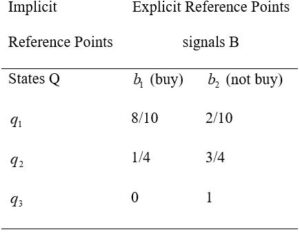
Using a Bayesian analysis the ex-ante reference points (prior beliefs) probabilities are:

Additionally the willingness to buy/not buy into one of the three quality categories is as follows:
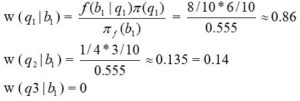
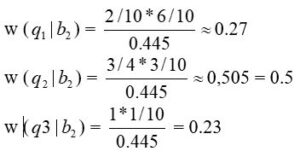
We clearly can see that prior belief of implicit/explicit reference points ![]() = (0.6, 0.3, 0.1) to willingness of:
= (0.6, 0.3, 0.1) to willingness of:
Buy: ![]()
Not Buy: ![]()
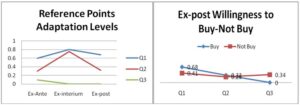
Figure 3: Update of reference points
Source: Author
The consumer is definitely willing to buy the camera that has excellent quality (86%), whereas the percentage of not buying a camera with good quality is 50%. The main conclusion of this mathematical example is that the consumer prior to being exposed to the three VGA (explicit reference points) he/she was almost sure for purchasing the brand that offers excellent quality (60%), as he had it as a reference point. Furthermore, our example gives new insights about how explicit reference points overlap with implicit in three different dimensions of time (ex-ante, ex-interium and ex-post). The results are shown graphically in Figure 4.
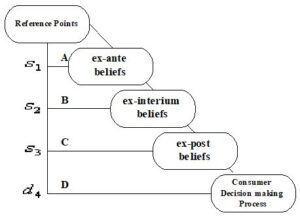
Figure 4: The triangle framework of reference points on consumer buying decision process
Source: Author
The proposed triangle framework is a result of our previous analysis, and the interpretation of constructs is as follows:
• A: = ex-ante beliefs: implicit and explicit reference points that have been formed by the consumer prior to exposition of real time consumer making decision
• B: = ex-interium beliefs: implicit and explicit reference points that have been formed by the consumer during to exposition of real time consumer making decision
• C: = ex-post beliefs: implicit and explicit reference points that have been formed by the consumer after to exposition of real time consumer making decision
• D: = Final selection of implicit and explicit reference points of consumer buying decision process
• ![]() : = are the stochastic transformation of the different reference points that change over time/situation or redefined as the consumer proceeds on each step of the decision making process
: = are the stochastic transformation of the different reference points that change over time/situation or redefined as the consumer proceeds on each step of the decision making process
• ![]() : = decision final
: = decision final
• Thus we define the stage from ![]() , and finally
, and finally ![]() , which is the final outcome of the perceived decision making process.
, which is the final outcome of the perceived decision making process.
In the context of consumer decision-making, ex-ante reference points are those that are established or taken into account prior to purchasing a product. Expectations and preferences are influenced by these reference points before the product or service is actually experienced. During the decision-making process itself, ex-interim reference points come into play. Additional information or factors that consumers encounter during the active evaluation of alternatives and making a choice might also be included. After the purchase decision has been executed, it is important to refer to ex-post reference points. These involve the customer evaluating their experience with the product or service, comparing it to their initial expectations, and having an impact on future decisions.
5 Conclusions, implications, future directions
According to our theoretical examination, scientists and managerial practitioners insofar followed the searching for reference point inside the axioms of „B“ to „C“ as a corner solution to explain the final evaluation of consumer decision-making outcomes, which is the point of „D“. The current research examined the conceptual and methodological processes mainly based on the impact of explicit reference points. Thus, our research proposes the searching of reference points through the linking of implicit referents. Having that in mind the experimental case study seeks to fill in that gap in the relevant literature review by trying to explain people’s choices from the perspective of reference-dependence theories. Finally, our proposed analysis via Bays rule, seeks to address multiple reference points, both implicit and explicit one, into the crafting of multicriteria decision-making problems that act upon the different time/conditions. The dynamic nature of consumer decision-making is highlighted by these time frame dimensions and the importance of managing and influencing reference points at different stages of the process. Understanding these time frames is crucial for marketers and researchers to analyze how reference points evolve and impact decision-making at various stages of the consumer journey. Marketers can tailor their strategies to create reference points before, during, and after the purchase to enhance customer satisfaction and loyalty.
Future scientists should attempt to extend the casual modeling of our effort by conducting other empirical case studies that examine the significant effects of implicit reference points. More specifically, our triangle analysis for the searching of reference points can be used in the construction of different experimental settings (and/or scenarios) by acting as a supplementary methodology in the examination of marketing problems related to the assessment of different information for analyzing the cognitive behavior of consumers in such as when consumers engage in impulsive behaviors, or when they are pressured to rely on more automatic evaluation processes and automatic associations, in order to examine whether explicit and implicit reference point processes operate independently or in parallel fashion. Also, our model can be examined by different decision-makers in the building of marketing strategies (i.e. to analyze from the perspective of consumer’s the settings of the marketing mix variables, let’s say the advertising research may be seen in the effects of brief exposures to consumer products to ads that flash by on Web pages or other media. Furthermore, with regard to the product portfolio, the implicit reference point’s measurements can be enhanced by carrying out additional experimental surveys using multicriteria decision-aid analysis (i.e. by the set of alternative weights).
In addition, our analysis can be utilized to investigate how consumers make their buying/purchase judgments based on the information labeling. For example, people (as consumers) tend to focus on positive/negative characteristics of the product depending on the positive/negative valence of the messages. Social psychologists and Neuro-marketers can examine the effects reference points on the consumer behaviors based on the modification of the brain, both anatomically and functionally, in response to the stimuli it receives from the environment which simply means that the brain does not stop changing. So the brain allows us with appropriate irritations to remodel it and teach it how to learn. Thus, when individuals are continuously exposed to certain stimuli, their brain starts an automatic learning process.
As a whole a significant contribution would be the examination of the critical features that informs the construction of reference points in the mind of the consumer, and how judgment and decision-making process are updated across a time line from initial interest in a set of product to actually considering purchasing one of those products or how the alternatives are eliminated (i.e. from a psychological perspective – as compared to a formal perspective. New technologies may reshape how consumers establish, access, and process reference points. For example, the rise of artificial intelligence, augmented reality, and virtual reality could provide more personalized and immersive experiences at each stage of the different time conditions. Scientists, can use this information to better understand and anticipate consumer needs, preferences, and decision-making processes.
Literatúra/List of References
- Arkes, H., Hirshleifer, D., Jiang, D. and Lim, S., 2007. A cross-cultural study of reference point adaptation: Evidence from China, Korea, and the US. In: Organizational Behavior and Human Decision Processes. 2007, 112(2), 99-111. ISSN 1095-9920. Available at: <https://doi.org/10.1016/j.obhdp.2010.02.002>
- Babutsidze, Z., 2012. How do consumers make choices? A survey of evidence. In: Journal of Economic Surveys. 2012, 26(4), 752-762. ISSN 0950-0804.
- Bahoo, S., Umar, R. M., Mason, M. C. and Zamparo, G., 2023. Role of theory of consumption values in consumer consumption behavior: a review and agenda. In: The International Review of Retail, Distribution and Consumer Research. 2023, 1-25. ISSN 0959-3969. Available at: <https://doi.org/10.1080/09593969.2023.2290657>
- Barkan, R., Danziger, S., Ben-Bashat, G. and Busemeyer, J. R., 2005. Framing reference points: the effect of integration and segregation on dynamic inconsistency. In: Journal of Behavioral Decision Making. 2005, 18, 213-226. ISSN 1099-0771. Available at: <https://onlinelibrary.wiley.com/doi/10.1002/bdm.496>
- Bettman, J. R., Luce, M. F. and Payne, J. W., 1998. Constructive consumer choice processes. In: Journal of Consumer Research. 1998, 25(3), 187-217. ISSN 0093-5301. Available at: <https://doi.org/10.1086/209535>
- Bouchouicha, R. and Vieider, F. M., 2017. Accommodating stake effects under prospect theory. In: Journal of Risk and Uncertainty. 2017, 55(1), 1-28. ISSN 1573-0476. Available at: <https://doi.org/10.1007/s11166-017-9266-y>
- Busemeyer, J. R., Barkan, R., Mehta, C. and Chaturvedi, A., 2007. Context effects and models of preferential choice: implications for consumer behavior. In: Marketing Theory. 2007, 7(1), 39-58. ISSN 1741-301X.
- Dholakia, U. M. and Simonson, I., 2005. The effect of explicit reference points on consumer choice and online bidding behavior. In: Marketing Science. 2005, 24(2), 206-217. ISSN 1526-548X. Available at: <https://doi.org/10.1287/mksc.1040.0099>
- Dimofte, C., 2010. Implicit measures of consumer cognition. In: Psychology and Marketing. 2010, 27(10), 921-937. ISSN 1520-6793. Available at: <https://doi.org/10.1002/mar.20366>
- Ghoshal, T., Yorkston, E., Nunes, J. C. and Boatwright, P., 2013. Multiple reference points in sequential hedonic evaluation: An empirical analysis. In: Journal of Marketing Research. 2013, 51(5), 563-577. ISSN 0022-2437. Available at: <https://doi.org/10.1509/jmr.12.007>
- Han, J., Qiu, C. and Popkowski Leszczyc, P., 2018. The effects of competitive reserve prices in online auctions. In: European Journal of Marketing. 2018, 52(7/8), 1439-1456. ISSN 0309-0566. Available at: <https://doi.org/10.1108/EJM-10-2017-0684>
- Hirshleifer, J. and Riley, J. G., 1992. The analytics of uncertainty and information. Cambridge: Cambridge University Press, 1992. ISBN 9781139167635.
- Kahneman, D., 1992. Reference points, anchors norms and mixed feelings. In: Organizational Behavior and Human Decision Processes. 1992, 51, 296-312. ISSN 1095-9920.
- Kahneman, D. and Tversky, A., 1979. Prospect theory: An analysis of decision under risk. In: Econometrica. 1979, 47, 263-291. ISSN 0012-9682. Available at: <https://doi.org/10.1142/9789814417358_0006>
- Kihlstrom, R. E., 1984. A ‘Bayesian’ exposition of Blackwell’s theorem on the comparison of experiments. In: Boyer, M. and Kihlstrom, R. E. (Eds.), Bayesian models of economic theory. New York: Elsevier, 1984, 13-31. ISBN 978-0444865021.
- Kurbanov, F., 2023. A study of the consumer behavior as the key to expanding the museum audience. In: Marketing Science & Inspirations. 2023, 18(1), 27-35. ISSN 1338-7944. Available at: <https://doi.org/10.46286/msi.2023.18.1.3>
- Laffont, J. J., 1989. The economics of uncertainty and information. MIT Press, 1989. ISBN 9780262121361.
- Mason, M. C., Oduro, S., Umar, R. M. and Zamparo, G., 2023. Effect of consumption values on consumer behavior: a meta-analysis. In: Marketing Intelligence & Planning. 2023, 41(7), 923-944. ISSN 0263-4503.
- Mayhew, G. E. and Winer, R. S., 1992. An empirical analysis of internal and external reference prices using scanner data. In: Journal of Consumer Research. 1992, 19(1), 62-70. ISSN 1537-5277. Available at: <https://doi.org/10.1086/209286>
- McGraw, A. P., Larsen, J. T. and Kahneman, D., 2010. Comparing gains and losses. In: Psychological Science. 2010, 21(10), 1438-1445. ISSN 1467-9280.
- Panzone, L. A., 2014. Why are discounted prices presented with full prices? The role of external price information on consumers’ likelihood to purchase. In: Food Quality and Preference. 2014, 31, 69-80. ISSN 0950-3293. Available at: <https://doi.org/10.1016/j.foodqual.2013.08.003>
- Puto, C. P., 1987. The framing of buying decisions. In: Journal of Consumer Research. 1987, 14, 301-315. ISSN 1537-5277. Available at: <https://doi.org/10.1086/209115>
- Shafir, E. and Thaler, R. H., 2006. Invest now, drink later, spend never: On the mental accounting of delayed consumption. In: Journal of Economic Psychology. 2006, 27, 694-712. ISSN 0167-4870.
- Sheth, J. N., Newman, B. I. and Gross, B. L., 1991. Why we buy what we buy: A theory of consumption values. In: Journal of Business Research. 1991, 22(2), 159-170. ISSN 0148-2963.
- Simonson, I. and Tversky, A., 1992. Choice in context: Tradeoff contrast and extremeness aversion. In: Journal of Marketing Research. 1992, 29(3), 281-295. ISSN 1547-7193. Available at: <https://doi.org/10.2307/3172740>
- Tarnanidis, T., Owusu-Frimpong, N. and Marciniak, R., 2010. Consumer choice: between explicit and implicit reference points. In: The Marketing Review. 2010, 10(3), 269-286. ISSN 1469-347X. Available at: <https://doi.org/10.1362/146934710X523113>
- Tarnanidis, T., Owusu-Frimpong, N., Nwankwo, S. and Omar, M., 2015. Why we buy? Modeling consumer selection of referents. In: Journal of Retailing and Consumer Services. 2015, 22(1), 24-36. ISSN 0969-6989.
- Thaler, R. H., 1985. Mental accounting and consumer choice. In: Marketing Science. 1985, 4(3), 199-214. ISSN 1526-548X. Available at: <https://doi.org/10.1287/mksc.4.3.199>
- Thaler, R. H., 2008. Mental accounting and consumer choice. In: Marketing Science. 2008, 27(1), 15-25. ISSN 1526-548X. Available at: <https://doi.org/10.1287/mksc.1070.0330>
- Tversky, A. and Shafir, E., 1992. The disjunction effect in choice under uncertainty. In: Psychological Science. 1992, 3(5), 305-309. ISSN 1467-9280.
- Van Osselaer, S. and Janiszewski, C., 2012. A goal-based model of product evaluation and choice. In: Journal of Consumer Research. 2012, 39(2), 260-292. ISSN 1537-5277.
- Van Osselaer, S. M. J. and Janiszewski, C., 2011. A goal-based model of product evaluation and choice. In: Journal of Consumer Research. 2011, 39(2), 260-292. ISSN 0093-5301. Available at: <https://doi.org/10.1086/662643>
- Van Ravenzwaaij, D., Moore, C. P., Lee, M. D. and Newel, l. R., 2014. A hierarchical Bayesian modeling approach to searching and stopping in multi‐attribute judgment. In: Cognitive Science. 2014, 38(7), 1384-1405. ISSN 0364-0213. Available at: <https://doi.org/10.1111/cogs.12119>
- Znanewitz, J., Braun, L., Hensel, D., Altobelli, C. F. and Hattke, F., 2018. A critical comparison of selected implicit measurement methods. In: Journal of Neuroscience, Psychology, and Economics. 2018, 11(4), 249-266. ISSN 2151-318X. Available at: <https://doi.org/10.1037/npe0000086>
Kľúčové slová/Key words
reference points, cognition, purchase decisions, prospect theory, Bayesian analysis
referenčné body, poznanie, nákupné rozhodnutia, prospektová teória, Bayesovská analýza
JEL klasifikácia/JEL Classification
M31
Résumé
Pochopenie referenčných bodov pri rozhodovaní o nákupe: prehľad, fázy a časové charakteristiky
Skúmanie referenčných bodov nebolo dôkladne preskúmané v oblasti spotrebiteľského rozhodovacieho procesu, ako sa uvádza v literatúre, chýba výskum, ktorý by skúmal používanie referenčných bodov v širšej škále atribútov, zameraných na konkrétne rozhodovacie sekvencie. Súčasný výskum ako taký zavádza nový prístup k snahe preskúmať účinky referenčných bodov (RP) na rozhodovací proces spotrebiteľa pri nákupe, ktorý sa opiera o tri časové dimenzie, ex-ante, ex-interiér a ex-post. Metodika, ktorá bola prijatá, je analýza prípadovej štúdie podľa zásad Bayesovskej analýzy, ktorá sa snaží odhaliť účinky referenčných bodov v procese rozhodovania spotrebiteľa o kúpe. Zistenia ukazujú, že preferencie referenčných bodov spotrebiteľov sa vytvárajú a štruktúrujú počas celého procesu nákupného rozhodovania a môžu sa modifikovať na základe potenciálnych signálov a zaujatých prístupov. Tieto dôsledky nás podnecujú k tomu, aby sme preskúmali tvorbu RP nad rámec ich fyzických alebo hmotných atribútov. Poznatky o hodnotení spotrebiteľov o používaní trojuholníkového rámca referenčných bodov, by mohli účinne využiť rôzni tvorcovia stratégií s cieľom účinnejšie podporovať a usmerňovať spotrebiteľov. V dôsledku toho sa teraz otvára veľa možností pre príležitostnú modelovú prax v budúcnosti.
Recenzované/Reviewed
4. December 2023 / 12. December 2023












